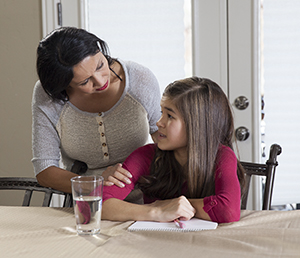Type 1 Diabetes and Your Child: High Blood Sugar
High blood sugar (hyperglycemia) happens when there is too much sugar (glucose) in the blood. Having high blood sugar increases the chance of complications from diabetes. Controlling blood glucose helps prevent complications. High blood sugar can occur due to:
-
Using too little insulin
-
Using insulin that’s not stored correctly or that’s past the expiration date
-
Eating too much food
-
Being sick (for example, having a cold, the flu, vomiting, or diarrhea)
-
Being less active than normal
-
Being under extra stress
-
Body's response to low blood sugar
-
Hormonal changes during puberty
-
Taking certain medicines that raise blood sugar, such as steroids
How to recognize high blood sugar
Your child may be thirsty. They may need to urinate often. Very high blood sugar may cause upset stomach, blurry vision, weakness, or dizziness. Help your child learn to recognize high blood sugar symptoms. Make sure your child knows to tell you about them right away. Educate your child's caregivers and teachers about these symptoms. Have your child wear a medic alert bracelet or necklace. But keep in mind that sometimes there are no symptoms.

How to treat high blood sugar
Check your child's blood glucose level. Depending on the result, do the following:
-
If blood glucose is over your child’s target range. Give your child water. Or give sugar-free and caffeine-free drinks.
-
If blood glucose is over 250 mg/dL. Check your child’s blood or urine for ketones. Ketones are the waste when the body burns fat instead of sugar for energy. The condition is called ketosis.
-
If your child’s blood glucose stays over 250mg/dL or your child has ketones. Call your child's healthcare provider.
-
Follow the plan from your child’s providers. This may include giving extra insulin.
If your child has ketones
Your child may have moderate to high ketone levels in their blood or urine. This is a warning sign of diabetic ketoacidosis (DKA). DKA is a medical emergency. To try to prevent DKA, you should:
-
Watch your child for symptoms of DKA. The symptoms include:
-
Follow the healthcare provider's directions for giving your child insulin.
-
Call the provider if your child has a high ketone level.
-
Check your child's blood glucose every few hours or more often if instructed to do so.
-
Don’t let your child exercise until ketones are back to normal.
If your child has ketones and symptoms of ketoacidosis, act quickly. Call 911 or take them to the hospital emergency room.
Sick days
When your child is sick, blood sugar may be higher than normal. This may be true even if your child is not eating as much as normal. To handle this, create a sick-day plan with your child’s healthcare provider. Sick-day plans often include:
-
More frequent blood glucose checks
-
Urine or blood ketone checks
-
Tips to keep your child hydrated
-
A special meal plan
-
Increased insulin
On sick days, keep in close contact with your child’s provider.
How to prevent high blood glucose
Make sure that:
-
Your child has the right amount of insulin. Make sure your child uses it on time.
-
Your child’s meals and snacks, exercise, and insulin are balanced during the day.
-
You follow your child's sick-day plan during an illness.
-
Insulin is stored correctly and has not expired.
-
Caregivers and teachers know the symptoms of hyperglycemia, emergency care, and how to contact you.